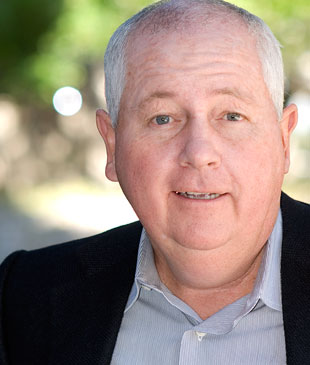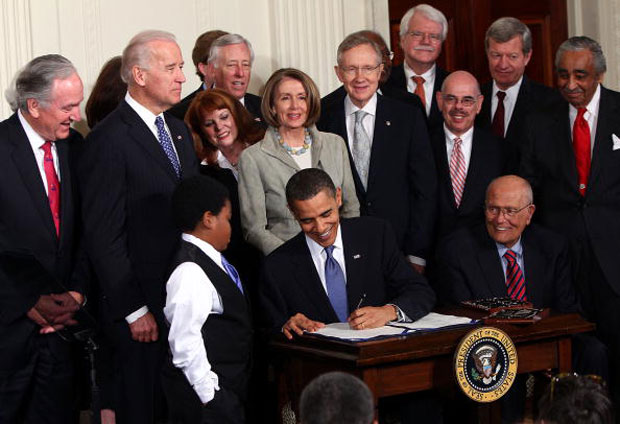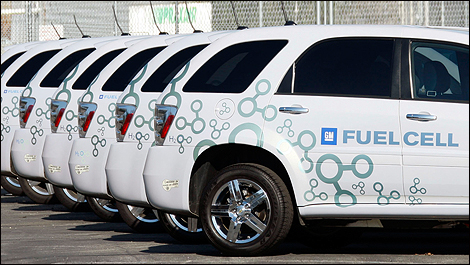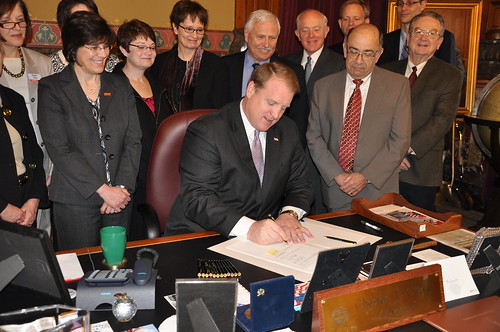 1. "That was a good presentation!"
1. "That was a good presentation!"
I have to say something positive, but you're not getting me to write a check. The fact is most funding pitches are terrible; they're more product pitches with an appeal for money tacked on at the end. Passion, yes, every entrepreneur has heard by now they must show great enthusiasm for their endeavor, but show me how I can get my money back someday, too. Who will acquire you? Are you going to raise venture capital which will keep me in the deal for 6, 7, 8, or 9 years? Or are you aware of the new trend towards early exits? Show me how I can get my money back in 3-5 years and even I'll be saying, "that was a good presentation!".
innovation DAILY
Here we highlight selected innovation related articles from around the world on a daily basis. These articles related to innovation and funding for innovative companies, and best practices for innovation based economic development.
UK space agency ready for take-off
 The government has launched a UK Space Agency dedicated to
coordinating the government's involvement in civilian spaceflight, with
responsiblity for looking after policy and budgets.
The government has launched a UK Space Agency dedicated to
coordinating the government's involvement in civilian spaceflight, with
responsiblity for looking after policy and budgets.
The national space agency, which officially begins work on 1 April, will negotiate on the UK's behalf with international bodies. In addition, it will take over responsibility for some key UK and European space projects, including Galileo, the Department for Business, Innovation and Skills (BIS) said in a statement on Tuesday.
The agency was set up to help spur growth in the British space and satellite industry, which employs 68,000 workers and generates £6.5bn a year, according to science and technology minister Lord Drayson.
China proposes trans-Eurasian rail system from London to Beijing
 The Chinese government is offering to subsidize the creation of a trans-Eurasian rail system that would have direct, high-speed links between Beijing and London. It would be the largest infrastructure project ever attempted. Trains would also run to India, Singapore, Vietnam, Thailand, Burma and Malaysia.
The Chinese government is offering to subsidize the creation of a trans-Eurasian rail system that would have direct, high-speed links between Beijing and London. It would be the largest infrastructure project ever attempted. Trains would also run to India, Singapore, Vietnam, Thailand, Burma and Malaysia.
Wang said Beijing was already in negotiations with 17 countries over the
rail lines, which would also allow China to transport raw materials
more efficiently.
"It was not China that pushed the idea to start with," said Wang. "It was the other countries that came to us, especially India. These countries cannot fully implement the construction of a high-speed rail network and they hoped to draw on our experience and technology."
France wants EU stock trading for 'high-growth' SMEs
 French Finance Minister Christine Lagarde wants the EU to create a single access point for trading shares of young, high-growth businesses and has proposed a range of measures to encourage innovative companies to list on European stock exchanges.
French Finance Minister Christine Lagarde wants the EU to create a single access point for trading shares of young, high-growth businesses and has proposed a range of measures to encourage innovative companies to list on European stock exchanges.
Lagarde is also keen to simplify market obligations for small, medium and intermediate companies, allowing them more time to publish quarterly reports, ease accounting standards and produce less detailed prospectuses when listing on stock markets.
"There are many things we disagree about but there is hardly ever disagreement on the importance of small businesses as drivers for growth, employment and R&D," she told a meeting in Brussels, hosted by the European Capital Markets Institute (ECMI).
The proposal for a joint EU system for trading shares in innovative companies is contained in a report by Fabrice Demarigny, a capital markets expert, who produced a a detailed plan for Lagarde which she published last week (18 March).
Angel Capital Education Foundation Newsletter


2010 ACA Summit, May 5 – 7 in San Francisco, CA
The Angel Capital Association’s annual conference includes best practices and networking with peers and “rock star” investors. The event attracts angels who invest in groups from around the world. ACEF offers a Pre-Summit agenda that includes several full- and half-day professional education workshops and seminars.Exit: CoreNetwork Has Exit in Twelve Months with Pump
Engineering, LLC
C Corporation Versus LLC: Which Entity Should Angels
Invest In?
(More articles on the Site)
Searching For Signs of a Comeback in San Diego’s Innovation Economy
 San Diego’s innovation economy obviously imploded last year—dragged down by general economic conditions that were hammered by the collapse in Southern California real estate, the breakdown of the capital markets, and a decline in tourism. Now there are signs that things are stabilizing, and might even be gradually improving, according to several reports released last week.
San Diego’s innovation economy obviously imploded last year—dragged down by general economic conditions that were hammered by the collapse in Southern California real estate, the breakdown of the capital markets, and a decline in tourism. Now there are signs that things are stabilizing, and might even be gradually improving, according to several reports released last week.
In a report on San Diego’s innovation economy, the Connect nonprofit group for technology and entrepreneurship found that 319 startups were launched in 2009—including 74 in the fourth quarter. That’s about 13 percent better than the 282 local startups that Connect counted in 2008, but still shy of the 332 startups formed in 2007. In its roundup of San Diego’s innovation economy, Connect also makes these points:
—The value of M&A deals in the San Diego area soared during the fourth quarter. Connect tallied 29 deals totaling nearly $1.3 billion that were closed, compared with 32 deals totaling $99 million in the previous quarter.
5 Hiring Tips for Startups
 From knowing who to hire next, to ethical and legal concerns, to how to interview the best candidates, to how to evaluate them once they're hired - startups have their work cut out for them when it comes to hiring.
From knowing who to hire next, to ethical and legal concerns, to how to interview the best candidates, to how to evaluate them once they're hired - startups have their work cut out for them when it comes to hiring.
If you can afford to hire a trained professional, someone who's skilled in evaluative testing, do so. But if not, you need to learn as much as you can about how to hire the right people. Here's our contribution to your endeavor.
How Does a Startup Know Who to Hire Next?
First it must be said that each startup has different needs. But in general, a startup that's still in pursuit of funding requires a sales-oriented team, whereas a startup with funding sources that have begun to stabilize can focus its team on more specific objectives.
In general, Anthony Cerminaro of AllBusiness says that the classic hiring stage starts with hiring someone to build a prototype. Then a manger is hired to turn the prototype into a product. Then a business manager is hired to coordinate business opportunities for the product. Then a lawyer is hired. Finally, someone is hired to focus on overall business development.
The Presidential Summit on Entrepreneurship, April 26-27, 2010, Washington, D.C.
The Presidential Summit on Entrepreneurship will convene on April 26-27 at the Ronald Reagan Building & International Trade Center in Washington, DC. It will include a diverse range of participants hailing from over 50 countries on five continents. The Summit will highlight the role entrepreneurship can play in addressing common challenges while building partnerships that will lead to greater opportunity abroad and at home.
In his June 4, 2009 speech in Cairo, President Obama called for a new relationship between the U.S. and Muslim communities around the world based on mutual respect, mutual interest, and mutual responsibility; a commitment to universal values; and broader engagement on issues including education, economic development, health, and science and technology. The Presidential Summit on Entrepreneurship is an example of this broader engagement.
2010 NYC BioScience Incentives Guide (NYCEDC)
 An in-depth look at the economic incentive programs available to support New York City’s emerging bioscience industry
An in-depth look at the economic incentive programs available to support New York City’s emerging bioscience industry
WHAT'S INSIDE
- Biotech Tax Credits
- Financing Programs
- Programs for Mid-stage and Mature Companies
- Key Contact Information
New York City and New York State have a range of valuable tax credits and incentives. This bioscience incentives guide is designed to help you take full advantage of these programs.
Download the PDF
From NYCEDC : New York City Economic Development Corporation
GE to Make Thin-Film Solar Panels
 GE has confirmed long-standing speculation that it
plans to make thin-film
solar panels that use a cadmium- and tellurium-based semiconductor
to capture light and convert it into electricity. The GE move could put
pressure on the
only major cadmium-telluride solar-panel maker, Tempe, AZ-based First Solar, which could drive down prices for solar
panels.
GE has confirmed long-standing speculation that it
plans to make thin-film
solar panels that use a cadmium- and tellurium-based semiconductor
to capture light and convert it into electricity. The GE move could put
pressure on the
only major cadmium-telluride solar-panel maker, Tempe, AZ-based First Solar, which could drive down prices for solar
panels.
Last year, GE seemed to be getting out of the solar industry as it sold off crystalline-silicon solar-panel factories it had acquired in 2004. The company found that the market for such solar panels--which account for most of the solar panels sold worldwide--was too competitive for a relative newcomer, says Danielle Merfeld, GE's solar technology platform leader.
She says cadmium-telluride solar is attractive to GE in part because, compared to silicon, there's still a lot to learn about the physics of cadmium telluride, which suggests it could be made more efficient, which in turn can lower the cost per watt of solar power. It's also potentially cheaper to make cadmium-telluride solar panels than it is to make silicon solar cells, making it easier to compete with established solar-panel makers. Merfeld says GE was encouraged by the example of First Solar, which has consistently undercut the prices of silicon solar panels--and because of this has quickly grown from producing almost no solar panels just a few years ago to being one of the world's largest solar manufacturers today.
Watch out: Innovators swarm Berkeley
 If you are interested in innovation and have $1,500 to spare, the
place to be the next few days will be at a conference at the
Haas School of Business.
If you are interested in innovation and have $1,500 to spare, the
place to be the next few days will be at a conference at the
Haas School of Business.
The Economist magazine is hosting the gathering, titled “Innovation: Fresh Thinking for the Ideas Economy.” With its impressive collection of leading thinkers, authors, journalists, academics, designers and businessmen, the conference aims to “expand or overturn established thinking about what innovation is, where it comes from, and how to make it work.”
Who's Cashing In on Health-Care Reform?
 If the health-care bill signed into law by President Obama today delivers on its promises, it's likely to down as the first ripple in a tidal wave of health-care information-technology innovation.
If the health-care bill signed into law by President Obama today delivers on its promises, it's likely to down as the first ripple in a tidal wave of health-care information-technology innovation.
It buoys last year's economic stimulus act, which slotted almost $20 billion to expanding health information technology (HIT). The new bill puts an even greater emphasis on electronic medical records and payment systems, for example, as the keys to successful health care reform.
And while the government is overhauling its own health care agencies first and foremost, its effects on the use of medical technology will certainly impact the private sector. According to a recent report from Accenture, for example, almost 60% of U.S. physicians in smaller practices who don’t use electronic medical records (EMRs) intend to purchase an EMR system within the next two years. That would be a leap from today's 6%. The biggest reason for the change? Federal legislation, which includes federal penalties for non-adoption.
What is Due Diligence?
 Many angel investors will tell you, that of the hundreds of business plans they receive each month, only a handful address the due diligence process. Investors will always allow a little puffery in a business plan, but they’ll also want to see the “proof in the pudding”, before any money changes hands. This is commonly referred to in the investment world as doing their “due diligence”.
Many angel investors will tell you, that of the hundreds of business plans they receive each month, only a handful address the due diligence process. Investors will always allow a little puffery in a business plan, but they’ll also want to see the “proof in the pudding”, before any money changes hands. This is commonly referred to in the investment world as doing their “due diligence”.
What is due diligence? Well, let say, you’ve just created the world’s first time machine, but it’s still only on the drawing board. Now, you need an angel investment to procure a few items to test it:
- 1981 DeLorean DMC-12 sports car;
- Photo-electric Chemical Power Converter (converts radioactive plutonium to electricity);
- Flux Capacitor (releases 1.21 gigawatts of energy in a millisecond);
- Plutonium (be careful or you’ll get a visit from Homeland Security);
- Blueprints for construction;
- Well documented preliminary test results and planned prototype testing;
- Michael J. Fox to test drive it “Back to the Future”.
State Funding of "Home Grown" Versus Existing Companies—New Report Advocates Funding Home Grown Companies
 An important theme in nanotechnology is state government pushing for
economic development through funding of nanotechnology high-tech
start-up companies and university technology transfer. Adding to this
push, a recent
report suggests that state governments should increasingly fund
“home grown” high-tech start-ups rather than provide money to
established companies. Home grown, turns out, provides better return for
the state. The report, titled "Good
Jobs, Strong Industries, a Better Pennsylvania: Towards a 21st Century
State Economic Development Policy," was prepared by the Keystone
Research Center and focused on developing jobs in Pennsylvania (see, for example, March 21, 2010 edition of the Pittsburgh Post-Gazette, D1, summarizing the report, case studies, and its implications). The reports’ implications, however, are national. In addition, the Keystone report also advocated for more transparency in how the state funding money is used and the results of the funding.
An important theme in nanotechnology is state government pushing for
economic development through funding of nanotechnology high-tech
start-up companies and university technology transfer. Adding to this
push, a recent
report suggests that state governments should increasingly fund
“home grown” high-tech start-ups rather than provide money to
established companies. Home grown, turns out, provides better return for
the state. The report, titled "Good
Jobs, Strong Industries, a Better Pennsylvania: Towards a 21st Century
State Economic Development Policy," was prepared by the Keystone
Research Center and focused on developing jobs in Pennsylvania (see, for example, March 21, 2010 edition of the Pittsburgh Post-Gazette, D1, summarizing the report, case studies, and its implications). The reports’ implications, however, are national. In addition, the Keystone report also advocated for more transparency in how the state funding money is used and the results of the funding.
General Motors Fuel Cell System for 2015 Commercialization
 As reported by General Motors
As reported by General Motors
Burbank, Calif. – General Motors Co. is testing a production-intent hydrogen fuel cell system that can be packaged in the space of a traditional four-cylinder engine and be ready for commercial production in 2015.
The system is half the size, 220 pounds lighter and uses about a third
of the platinum of the system in the Chevrolet
Equinox Fuel Cell electric vehicles used in Project Driveway, the
world’s largest market test and demonstration fleet of fuel cell electric
vehicles that began in late 2007 and has amassed nearly 1.3 million
miles of everyday driving in cities around the world.
“Our learning from Project Driveway has been tremendous and these
vehicles have been very important to our program,” Charles Freese,
executive director of GM's Global Fuel Cell Activities told reporters
Tuesday at a news briefing on GM’s fuel cell progress.
Castile Ventures Showing How A Small-Fund Strategy Can Work
 The venture industry lately has been singing the praises of small
funds, but Castile Ventures has been
practicing the strategy for more than a decade.
The venture industry lately has been singing the praises of small
funds, but Castile Ventures has been
practicing the strategy for more than a decade.
To understand the firm’s culture, says founder and Managing General Partner Nina Saberi, you have to know how she grew as an entrepreneur, working in the ranks of venture-backed companies after graduating from college in the 1980s and then running them in the 1990s. Along the way she was mentored by the likes of ComVentures co-founder Cliff Higgerson and Crosspoint Venture Partners founder John Mumford, both of whom helped her launch Castile in 1998.
Saberi watched the venture industry grow, with fund sizes ballooning to $300 million, $500 million and eventually north of $1 billion, and didn’t get it. “For someone who comes from the company-building side of things, I was just puzzled by the whole dynamic,” she said. “I didn’t understand why suddenly it should cost $70 million to build a company that you were able to build for maybe $25 million or $35 million just a year before.”
Can This Egg Beater Double the Power Output of Wind Farms?
 There are a lot of extra acres on wind farms.
There are a lot of extra acres on wind farms.
That, in part, is the idea behind Wind Harvest International, which says it can double to power output of large wind farms by strategically placing its vertical wind turbines between the large, multi-megawatt horizontal turbines that stand in them now.
In fact, the company's "I am the spare arms of Robby the Robot" turbines might even be able to increase the power output of the existing, multi-megawatt, multimillion-dollar turbines already in the ground.
"We can put a megawatt of turbines between two horizontal megawatt turbines," said Kevin Wolf, the company's chief operating officer. "We can double the power output and maybe increase the power of the other turbines."
World's strongest animal effectively benches a thousand times its body weight
 Even if a grown man could pull 95,000 kilograms, he still would get shown up by the newly crowned world's strongest insect—proportionally speaking.
Even if a grown man could pull 95,000 kilograms, he still would get shown up by the newly crowned world's strongest insect—proportionally speaking.
Researchers recently discovered that this honor should go to the Onthophagus
taurus dung
beetle, whose strongest males can pull some 1,140 times their own
body weight, the research team reported in a press release.
(Consolations to the rhinoceros beetle, which has frequently been given
the title for pulling about 850 times its weight.) The findings came
about as part of a study published online March 23 in Proceedings
of the Royal Society B.
"Insects are well known for being able to perform amazing feats of
strength, and it's all on account of their curious
sex lives," Robert Knell, of the School of Biological and Chemical
Sciences at Queen Mary University of London, and lead author of the
study, said in a prepared statement.
Governor Culver Joins Business Leaders to Create Iowa Innovation Council

DES MOINES – Governor Chet Culver today signed legislation creating the Iowa Innovation Council, a group of volunteer private business leaders who will work to help ensure Iowa is competitive in the global business economy.
House File 2076 consolidates three existing councils within the Iowa Department of Economic Development: the Bioscience Alliance, Advanced Manufacturing Council and Information Technology Council. Leaders of these groups developed the concept of the Iowa Innovation Council, and they will continue to lead in developing strategies and long-term plans for innovation in targeted industries in Iowa.
Reminder: Join Us For an Interactive Webinar on New Model for Drug Development

Join Our Discussion
1 p.m. EDT, Noon CDT, 10 a.m. PDT
Developing Cures with Less Time & Capital:
A New Research Model to Accelerate Drug Development
WEBINAR LINK:
https://kauffman.webex.com
Password: discussion
CALL-IN NUMBER:
719-325-2331 or toll-free, 888-430-8690
Confirmation Code: 2798343
The Myelin Repair Foundation's approach will not only benefit the millions living with MS but also provides a new source of high-quality drug targets for the dwindling biopharma pipelines. Learn why the Ewing Marion Kauffman Foundation, Pioneer Portfolio of the Robert Wood Johnson Foundation, and the Scott Cook & Signe Ostby Foundation are investing in MRF's unique approach, its potential to accelerate the drug development process, and why this should call attention to the demand for a new research paradigm. The session will include an interactive Q&A portion where participants can direct questions to participating panelists.
WHO:
Scott Johnson, President and Founder, Myelin Repair Foundation
Lesa Mitchell, Vice President, Advancing Innovation, Kauffman Foundation
Nancy Barrand, Special Advisor for Program Development, Robert Wood Johnson Foundation
Scott Cook, Co-founder of the Scott Cook & Signe Ostby Foundation and Co-founder of Intuit Inc.
Contact Information:
Martin Maisonpierre
This email address is being protected from spambots. You need JavaScript enabled to view it.
Office: (212) 704-8111
Please follow the online conversation about the call on Twitter by following the hash tag #myelincures.



